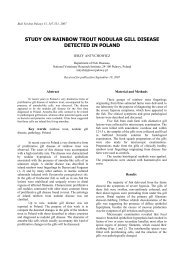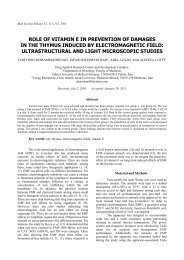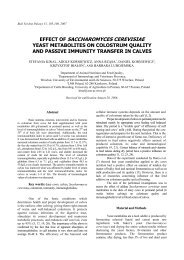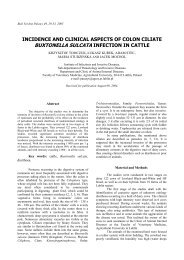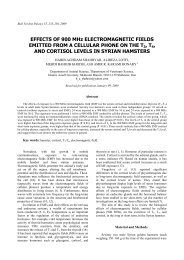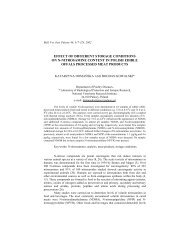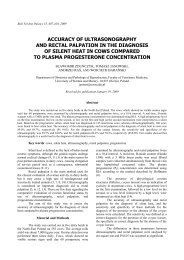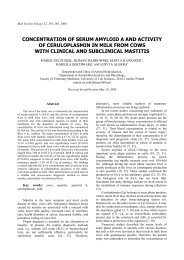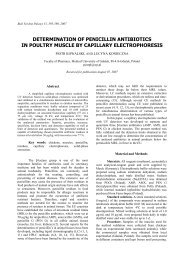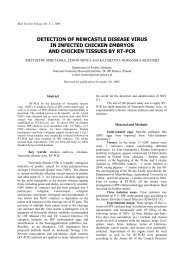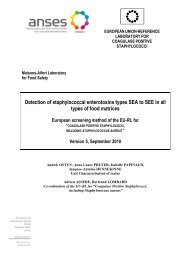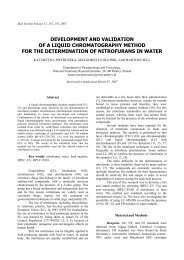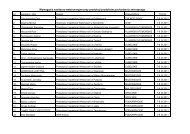Irradiation and Trade in Food and Agricultural Products - Nuclear ...
Irradiation and Trade in Food and Agricultural Products - Nuclear ...
Irradiation and Trade in Food and Agricultural Products - Nuclear ...
- No tags were found...
You also want an ePaper? Increase the reach of your titles
YUMPU automatically turns print PDFs into web optimized ePapers that Google loves.
<strong>Irradiation</strong> <strong>and</strong> <strong>Trade</strong> <strong>in</strong><strong>Food</strong> <strong>and</strong> <strong>Agricultural</strong> <strong>Products</strong>International Consultative Group on <strong>Food</strong> <strong>Irradiation</strong>(ICGFI)The ICGFI SecretariatJo<strong>in</strong>t FAO/IAEA Division of <strong>Nuclear</strong> Techniques<strong>in</strong> <strong>Food</strong> <strong>and</strong> Agriculture,Wagramerstrasse 5,P.O.Box 100,A-1400 Vienna, Austria
ContentsForeword 5Executive Summary 6Introduction 8Problems <strong>in</strong> <strong>Trade</strong> <strong>in</strong> <strong>Food</strong> <strong>and</strong> <strong>Agricultural</strong> Commodities 9<strong>Food</strong> safety <strong>and</strong> foodborne illness issues 9Presence of pests 9Availability <strong>and</strong> seasonality issues 9Market access 9Assess<strong>in</strong>g <strong>Irradiation</strong> <strong>and</strong> Other Technologies Available to Resolve<strong>Trade</strong> Issues Concern<strong>in</strong>g <strong>Food</strong> <strong>and</strong> <strong>Agricultural</strong> <strong>Products</strong> 10The Place of <strong>Irradiation</strong> <strong>in</strong> the <strong>Food</strong> Distribution Cha<strong>in</strong> 11The Future for <strong>Trade</strong> <strong>in</strong> Irradiated <strong>Food</strong> 12Regulations that Affect <strong>Trade</strong> <strong>in</strong> <strong>Food</strong> <strong>and</strong> <strong>Agricultural</strong> <strong>Products</strong> 13International 13Regional 14National 14Conclusions <strong>and</strong> Recommendations 15Bibliography 16
<strong>Irradiation</strong> <strong>and</strong> <strong>Trade</strong> <strong>in</strong> <strong>Food</strong> <strong>and</strong> <strong>Agricultural</strong> <strong>Products</strong>ForewordThe International Consultative Group on<strong>Food</strong> <strong>Irradiation</strong> (ICGFI) was established on9 May 1984 under the aegis of FAO, IAEA <strong>and</strong>WHO. ICGFI is composed of experts <strong>and</strong>other representatives designated by governmentswhich have accepted the terms of the“Declaration” establish<strong>in</strong>g ICGFI <strong>and</strong> havepledged to make voluntary contributions, <strong>in</strong>cash or <strong>in</strong> k<strong>in</strong>d, to carry out the activities ofICGFI.The functions of ICGFI are as follows:❐ to evaluate global developments <strong>in</strong> thefield of food irradiation;❐ to provide a focal po<strong>in</strong>t of advice onthe application of food irradiation toMember States <strong>and</strong> the Organizations;<strong>and</strong>❐ to furnish <strong>in</strong>formation as required,through the Organizations, to the Jo<strong>in</strong>tFAO/IAEA/WHO Expert Committeeon the Wholesomeness of Irradiated<strong>Food</strong>, <strong>and</strong> the Codex AlimentariusCommission.As of May 1998, the follow<strong>in</strong>g countriesare members of ICGFI:Argent<strong>in</strong>a, Australia, Bangladesh, Belgium,Brazil, Bulgaria, Canada, Chile, Costa Rica,Côte d’Ivoire, Croatia, Cuba, Czech Republic,Ecuador, Egypt, France, Germany, Ghana,Greece, Hungary, India, Indonesia, Iraq, Israel,Italy, Republic of Korea, Malaysia, Mexico,Morocco, Netherl<strong>and</strong>s, New Zeal<strong>and</strong>, Pakistan,People’s Republic of Ch<strong>in</strong>a, Peru, Philipp<strong>in</strong>es,Pol<strong>and</strong>, Portugal, South Africa, Syrian ArabRepublic, Thail<strong>and</strong>, Tunisia, Turkey, Ukra<strong>in</strong>e,United K<strong>in</strong>gdom, United States of America,Viet Nam, <strong>and</strong> Yugoslavia.The 11th Annual Meet<strong>in</strong>g of ICGFI held<strong>in</strong> Bali, Indonesia, November 1994 requestedthat a comprehensive Programme of Work<strong>and</strong> Budget of ICGFI for 1996-98 be developedto facilitate the consideration of ICGFImember governments on the extension of itsm<strong>and</strong>ate. A Work<strong>in</strong>g Group was thereforeconvened for this purpose <strong>in</strong> Vienna <strong>in</strong> April1995 which recommended, among otherth<strong>in</strong>gs, that urgent consideration be given tothe development of ICGFI documents whichwould clearly def<strong>in</strong>e the role that irradiationcan play <strong>in</strong> achiev<strong>in</strong>g the general policy goalsendorsed by Member States of various UNOrganizations. Five such policy documents <strong>in</strong>the areas of <strong>Food</strong> Safety, <strong>Food</strong> Security, <strong>Trade</strong>Development, Environment, <strong>and</strong> EnergyConservation were recommended by theWork<strong>in</strong>g Group. However, <strong>in</strong> view of thef<strong>in</strong>ancial constra<strong>in</strong>ts, the 12th ICGFI AnnualMeet<strong>in</strong>g held <strong>in</strong> Vienna, November 1995,decided to prepare only the first three suchdocuments.This document was prepared by Ms.Michelle Marcotte, a freelance consultant onfood irradiation based <strong>in</strong> Ottawa, Canada, onbehalf of ICGFI. It expla<strong>in</strong>s the comparativeadvantages of irradiation as a method to meetsanitary <strong>and</strong> phytosanitary requirements <strong>in</strong><strong>in</strong>ternational trade <strong>in</strong> food <strong>and</strong> agriculturalcommodities. After undergo<strong>in</strong>g peer review<strong>and</strong> comments by national contact po<strong>in</strong>ts ofICGFI <strong>and</strong> subsequent revisions by theauthor, this document was approved for publicationas one of the <strong>in</strong>formation documentsby the 14th ICGFI Meet<strong>in</strong>g. The ICGFISecretariat gratefully acknowledge the valuablecontribution of Ms. Marcotte <strong>and</strong> thosewho were <strong>in</strong>volved <strong>in</strong> review<strong>in</strong>g this document.This document was professionallyedited by Mr. R. Peniston-Bird, a former editorof IAEA.5
<strong>Irradiation</strong> <strong>and</strong> <strong>Trade</strong> <strong>in</strong> <strong>Food</strong> <strong>and</strong> <strong>Agricultural</strong> <strong>Products</strong>Executive Summary<strong>Trade</strong> <strong>in</strong> food <strong>and</strong> agricultural productsis important to all countries; the economiesof many develop<strong>in</strong>g countries would be significantlyimproved if they were able to exportmore food <strong>and</strong> agricultural products.Unfortunately, many products can not betraded because they are <strong>in</strong>fested with, or hoststo, harmful pests, contam<strong>in</strong>ated with microorganisms,or spoil quickly. As a result, manydevelop<strong>in</strong>g countries cannot build strongeconomies <strong>and</strong> consumers do not have accessto the wealth of foods <strong>and</strong> products that couldcontribute to health <strong>and</strong> enjoyment of life.<strong>Food</strong>s contam<strong>in</strong>ated with microorganismscause economic losses, widespread illness <strong>and</strong>death.Several technologies <strong>and</strong> products havebeen developed to resolve problems <strong>in</strong> trad<strong>in</strong>gfood <strong>and</strong> to improve food safety, but none canprovide all the solutions. Some chemical fumigantscurrently <strong>in</strong> use are harmful to people<strong>and</strong>/or the environment. Other technologies,such as controlled atmospheres, may requirespecial equipment or storage facilities <strong>and</strong>may be expensive. Regulatory approval is alsoan issue when controlled atmospheres areused for pest control. Heat treatments suchas cann<strong>in</strong>g are commonly used to resolveproblems such as bacterial contam<strong>in</strong>ation orshort shelf-life. Canned foods are very differentfrom the orig<strong>in</strong>al product; some haveexcellent consumer acceptance, others maynot be rated as highly as fresh products.Certa<strong>in</strong> heat treatments sometimes damagefruit.<strong>Irradiation</strong> is an effective technology toresolve technical problems <strong>in</strong> trade of manyfood <strong>and</strong> agricultural products, either as ast<strong>and</strong>-alone technology or <strong>in</strong> comb<strong>in</strong>ationwith others. As a dis<strong>in</strong>festation treatment itallows different levels of quarant<strong>in</strong>e security tobe targeted <strong>and</strong> it is one of few methods tocontrol <strong>in</strong>ternal pests. As a dis<strong>in</strong>fection treatmentit offers good, broad spectrum control ofmany pathogenic <strong>and</strong> spoilage organismswith m<strong>in</strong>imal change to the food.The ability of irradiation virtually to elim<strong>in</strong>atekey pathogenic organisms from meat,poultry <strong>and</strong> spices is an important publichealth advantage. The huge number of casesof illness <strong>and</strong> death from pathogenic bacteria<strong>in</strong> meats <strong>and</strong> poultry represents a terriblewaste of human <strong>and</strong> economic potential, particularlywhen a technology that could preventa large percentage of such cases isavailable. <strong>Irradiation</strong> also offers clear advantagesover chemical <strong>and</strong> heat treatments forspices, <strong>in</strong> terms of bacterial control <strong>and</strong> ma<strong>in</strong>tenanceof organoleptic properties. S<strong>in</strong>ce spicesare so widely used <strong>in</strong> processed foods, thisbeneficial effect of irradiation is multiplied.In addition to controll<strong>in</strong>g pests <strong>and</strong> elim<strong>in</strong>at<strong>in</strong>gharmful bacteria, irradiation alsoextends the storage life of many foods; thiseffect makes irradiation particularly useful fortropical fruits, commonly <strong>in</strong>fested <strong>and</strong> alsorequir<strong>in</strong>g extended shelf-life to reach consumermarkets <strong>in</strong> good quality. Although irradiationis often clearly a superior technology,there are constra<strong>in</strong>ts that restrict its use, <strong>in</strong>clud<strong>in</strong>glack of regulatory approvals, labell<strong>in</strong>gissues <strong>and</strong> lack of consumer <strong>in</strong>formation <strong>and</strong>underst<strong>and</strong><strong>in</strong>g.Harmonization of sanitary <strong>and</strong> phytosanitarymeasures was negotiated <strong>in</strong>tenselyunder the Uruguay Round of the GeneralAgreement on Tariffs <strong>and</strong> <strong>Trade</strong> (GATT), <strong>and</strong>detailed <strong>in</strong> two technical trade agreements:on the Application of Sanitary <strong>and</strong>Phytosanitary Measures (SPS), <strong>and</strong> onTechnical Barriers to <strong>Trade</strong> (TBT). An importantpr<strong>in</strong>ciple, that of equivalence, was agreed6
<strong>Irradiation</strong> <strong>and</strong> <strong>Trade</strong> <strong>in</strong> <strong>Food</strong> <strong>and</strong> <strong>Agricultural</strong> <strong>Products</strong>to <strong>in</strong> these negotiations. With<strong>in</strong> the SPSAgreement, the pr<strong>in</strong>ciple of equivalencyrelates to recogniz<strong>in</strong>g the validity of alternativesfor achiev<strong>in</strong>g an equivalent outcome.Equivalence will be key to mov<strong>in</strong>g regulatoryagencies from prescriptive treatments towardsst<strong>and</strong>ards <strong>and</strong> towards a focus on outcomesrather than specific processes. Governmentswill be obliged to accept any measures whichcan achieve the same results. This pr<strong>in</strong>cipleshould result <strong>in</strong> greater acceptance of irradiatedfoods <strong>in</strong> <strong>in</strong>ternational trade.In summary, measures to h<strong>and</strong>le technicalor pest problems should not be more traderestrictive than necessary to achieve a legitimateprotection objective. To ensure nationalregulations can withst<strong>and</strong> the <strong>in</strong>evitable courtchallenges, efforts should be made to ensurethat no discrim<strong>in</strong>ation aga<strong>in</strong>st irradiated food,processed accord<strong>in</strong>g to the pr<strong>in</strong>ciple of theCodex St<strong>and</strong>ard, is <strong>in</strong>troduced <strong>in</strong>to nationalregulations.Regulations on food irradiation vary widely- from broad acceptance of several food classesto limited acceptance of a few food items, <strong>and</strong>from prohibition to complete silence on thesubject. Such disharmonious regulations arebarriers to trade <strong>in</strong> irradiated foods.7
<strong>Irradiation</strong> <strong>and</strong> <strong>Trade</strong> <strong>in</strong> <strong>Food</strong> <strong>and</strong> <strong>Agricultural</strong> <strong>Products</strong>Problems <strong>in</strong> <strong>Trade</strong> <strong>in</strong> <strong>Food</strong> <strong>and</strong> <strong>Agricultural</strong>Commodities<strong>Food</strong> safety <strong>and</strong> foodborneillness issuesBacterial contam<strong>in</strong>ation can <strong>and</strong> frequentlydoes cause human illness. Accord<strong>in</strong>g to theWorld Health Organization (WHO), illnessdue to contam<strong>in</strong>ated food is perhaps the mostwidespread health problem <strong>in</strong> the contemporaryworld <strong>and</strong> an important cause of reducedeconomic productivity. <strong>Trade</strong> <strong>in</strong> many foodproducts, usually meat, poultry <strong>and</strong> mar<strong>in</strong>efoods, is sometimes constra<strong>in</strong>ed because ofmicrobial contam<strong>in</strong>ation. These foods can becontam<strong>in</strong>ated, even when processed us<strong>in</strong>ggood manufactur<strong>in</strong>g practices. Rapid spoilagecaused by microbial contam<strong>in</strong>ants, enzyme<strong>and</strong> other chemical reactions is also an issue.Presence of pestsInsects <strong>and</strong> other pests can be present on<strong>and</strong> <strong>in</strong> many horticultural foods <strong>and</strong> agriculturalproducts. Pests of perishable foods mayentail quarant<strong>in</strong>e, s<strong>in</strong>ce these foods have ashort shelf-life. Pests of stored foods or agriculturalproducts are usually a cause for economicconcern s<strong>in</strong>ce they can cause seriousstorage losses as well as damage to theimport<strong>in</strong>g country. If pests are not alreadyknown or not established <strong>in</strong> the import<strong>in</strong>gcountry, the host product may be prohibited,or may have to be dis<strong>in</strong>fested before be<strong>in</strong>gallowed entry.The agricultural fumigant most used forthis purpose, methyl bromide (MB), has beenlisted as an ozone deplet<strong>in</strong>g substance underthe United Nations Montreal Protocol <strong>and</strong> itsproduction must be phased out. Other chemicaltreatments applied as dips or sprays are<strong>in</strong>creas<strong>in</strong>gly be<strong>in</strong>g viewed as not <strong>in</strong> the best<strong>in</strong>terests of human or environmental health. Insome cases, governments are phas<strong>in</strong>g outthese products, <strong>in</strong> other cases, consumersare dem<strong>and</strong><strong>in</strong>g that chemical treatments bereplaced. The trend is towards the elim<strong>in</strong>ationof many chemical treatments.Availability <strong>and</strong>seasonality issuesUnlike manufactured products, agriculturalcommodities are often only availableseasonally <strong>and</strong> harvest quantities may varyfrom year to year. These factors make trademore risky <strong>and</strong> often more expensive. Onthe other h<strong>and</strong>, cont<strong>in</strong>u<strong>in</strong>g dem<strong>and</strong> forsome products encourages their tradebetween grow<strong>in</strong>g regions. Often though,significant losses <strong>and</strong> quality downgrad<strong>in</strong>gof seasonal products occur because of theirshort shelf-life, the need to use <strong>in</strong>expensivetransport systems <strong>and</strong> the long distancesthe product must travel.Market accessSeveral regulatory <strong>and</strong> technical barriersto trade exist for various reasons.Treatment regimens required or allowed byone country may not be available orallowed <strong>in</strong> another country. This is often theproblem with irradiation s<strong>in</strong>ce regulationsgovern<strong>in</strong>g the use of irradiation varywidely. Many trade barriers are not sufficientlywell grounded <strong>and</strong> may have beendevised to protect local growers from competition.Political <strong>in</strong>fluences commonlymake trade difficult, slow<strong>in</strong>g or prevent<strong>in</strong>gtrade possibilities. Under the GeneralAgreement on Tariffs <strong>and</strong> <strong>Trade</strong> (GATT)these differences must be overcome <strong>and</strong>national regulations adapted accord<strong>in</strong>gly.9
<strong>Irradiation</strong> <strong>and</strong> <strong>Trade</strong> <strong>in</strong> <strong>Food</strong> <strong>and</strong> <strong>Agricultural</strong> <strong>Products</strong>Assess<strong>in</strong>g <strong>Irradiation</strong> <strong>and</strong> Other TechnologiesAvailable to Resolve <strong>Trade</strong> Issues Concern<strong>in</strong>g<strong>Food</strong> <strong>and</strong> <strong>Agricultural</strong> <strong>Products</strong><strong>Irradiation</strong> is an effective technology forresolv<strong>in</strong>g technical trade issues for many food<strong>and</strong> agricultural products. As a dis<strong>in</strong>festationtreatment it allows the possibility of target<strong>in</strong>gdifferent levels of quarant<strong>in</strong>e security <strong>and</strong> it isone of few methods to control <strong>in</strong>ternal pests.As a dis<strong>in</strong>fection treatment it offers good broadspectrum control of many pathogenic <strong>and</strong>spoilage organisms with m<strong>in</strong>imal change to thefood. Although it is often clearly a superiortechnology, there are constra<strong>in</strong>ts that restrict itsuse.One important constra<strong>in</strong>t is lack of regulatoryapproval <strong>in</strong> import<strong>in</strong>g countries, eventhough the same countries may allow the irradiationof the same product for export. Manycountries, particularly major importers, cont<strong>in</strong>ueto require extensive <strong>and</strong> food-specificapproval petitions that are then reviewed atlength, with often no approvals result<strong>in</strong>g. Thisprocess, frequently based on bureaucratic <strong>in</strong>terpretationof regulatory requirements, representsa key constra<strong>in</strong>t to the implementation of irradiation,<strong>and</strong> a key discouragement to the food<strong>in</strong>dustry.Whilst labell<strong>in</strong>g can assist consumers whoare <strong>in</strong>terested <strong>in</strong> irradiation for the benefits itoffers <strong>in</strong> help<strong>in</strong>g them f<strong>in</strong>d the foods they want,labell<strong>in</strong>g requirements for irradiated foods areseen by the food <strong>in</strong>dustry <strong>in</strong> some countries asa h<strong>and</strong>icap because it assumes that consumershold negative op<strong>in</strong>ions concern<strong>in</strong>g irradiation.S<strong>in</strong>ce labell<strong>in</strong>g is not required for many competitivetreatments, such as chemical fumigation,the imposition of such requirements forirradiated food may be seen as an unfair technicaltrade barrier. Given the unfair market<strong>in</strong>gposition <strong>and</strong> additional expense of m<strong>and</strong>atorylabell<strong>in</strong>g of irradiated foods when competitivechemical treatments do not require it, labell<strong>in</strong>gof irradiated foods should be voluntary.Consumer attitudes, real or perceived,also constra<strong>in</strong> the use of irradiation. Oftenperceptions of consumer attitudes are basedon personal observations, or a political analysis,as opposed to consumer research or markettest<strong>in</strong>g. This perception then affectsdecisions at regulatory <strong>and</strong> <strong>in</strong>dustry levels,sometimes to the detriment of overall health<strong>and</strong> economic goals.For irradiation to be useful <strong>in</strong> resolv<strong>in</strong>g afood trade or technical problem, a countrymust have a sufficiently developed <strong>in</strong>frastructure.<strong>Food</strong> transport <strong>and</strong> distributionmechanisms must be <strong>in</strong> place as well as goodstorage, <strong>and</strong> sometimes refrigeration storage.Although available <strong>in</strong> many countries, irradiationequipment is sometimes not accessiblefor research or commercial treatments forfood products.Often the capital costs of irradiationequipment are seen as prohibitive, eventhough low operat<strong>in</strong>g costs make per unitcosts for most commodities very competitivewith other treatments. Fortunately, however,commercial contract multipurpose irradiatorsoperate <strong>in</strong> many countries offer<strong>in</strong>g irradiationservices at reasonable cost. S<strong>in</strong>ceirradiation gives the added economic benefitof prolonged fresh market life for manyfoods, decreased waste <strong>and</strong> <strong>in</strong>creased marketpotential of the food should be considered<strong>in</strong> a cost-benefit analysis.Tables I-IV provide a quick reference to thema<strong>in</strong> food <strong>and</strong> agricultural products traded.Each table refers to a commodity group, thetrade problems often associated with the commodities,some current or potential technologiesto resolve the trade issues as well as theconstra<strong>in</strong>ts, effectiveness <strong>and</strong> relative costsassociated with the technologies.10
<strong>Irradiation</strong> <strong>and</strong> <strong>Trade</strong> <strong>in</strong> <strong>Food</strong> <strong>and</strong> <strong>Agricultural</strong> <strong>Products</strong>The Place of <strong>Irradiation</strong> <strong>in</strong> the <strong>Food</strong>Distribution Cha<strong>in</strong>The purpose irradiation fulfils <strong>in</strong> the process<strong>in</strong>gor h<strong>and</strong>l<strong>in</strong>g of a food will dictatewhere irradiation fits <strong>in</strong> the food distributioncha<strong>in</strong>. Fortunately, irradiation is reasonablyversatile <strong>and</strong> could fit <strong>in</strong> several,but not all, l<strong>in</strong>ks of the cha<strong>in</strong>.<strong>Irradiation</strong> is most often viewed as be<strong>in</strong>gthe last process after packag<strong>in</strong>g. In this way,foods such as meat, poultry <strong>and</strong> shellfishcan be irradiated to control pathogenic <strong>and</strong>spoilage organisms with a reasonable assurancethat the product will not be further contam<strong>in</strong>atedbefore purchase by the consumeror food service operator. Where these foodsare to be further processed <strong>in</strong> a HazardAnalysis Critical Control Po<strong>in</strong>ts (HACCP)environment, <strong>and</strong> where control of specificpathogenic bacteria is required, there is alsoan argument for irradiation at the bulk productstage, for example irradiation of carcassesof beef before ground beef patties aremade.In other <strong>in</strong>stances, irradiation is a pestdis<strong>in</strong>festation method. Where irradiationfacilities exist, <strong>and</strong> where a sufficient level ofassurance can be given to the import<strong>in</strong>gcountry about the exclusion of pests dur<strong>in</strong>gshipp<strong>in</strong>g <strong>and</strong> h<strong>and</strong>l<strong>in</strong>g, irradiation dis<strong>in</strong>festationcan be done at the port of exit. Inother <strong>in</strong>stances, some country <strong>in</strong>spection servicesmay require the assurance that irradiationfor pest control be carried out at theport of import. The product can either bepackaged <strong>in</strong> wholesale boxes, such as thosecommonly used for fruit, or the product maybe <strong>in</strong> bulk, such as gra<strong>in</strong> or dry <strong>in</strong>gredients.In the case of packaged foods, the packag<strong>in</strong>gmust exclude the re-entry of pests. In bulkproducts, the transport or storage conta<strong>in</strong>ermust be free of pests, <strong>and</strong> it would be advisableto ensure that any pests that re-enterthe product do not survive. In these<strong>in</strong>stances, the use of an effective diatomaceousearth to dis<strong>in</strong>fest the transport or storagemechanism before the gra<strong>in</strong> is added,or apply<strong>in</strong>g a very small amount of diatomaceousearth to the top of the carrier mightbe a good comb<strong>in</strong>ation practice. Where storagefacilities are sufficiently airtight, storageunder carbon dioxide may also be apotential comb<strong>in</strong>ation treatment. For someproducts, lower storage temperature mightalso work to exclude pests.Spices are commonly irradiated, ma<strong>in</strong>lyto reduce bacterial <strong>and</strong> mold counts,although sometimes pests are an issue.Usually spices are irradiated <strong>in</strong> bulk bags orbarrels before further process<strong>in</strong>g by the spiceblender, or before use as <strong>in</strong>gredients <strong>in</strong> foodproducts. In other <strong>in</strong>stances, small spicepackets, <strong>in</strong>cluded <strong>in</strong> packaged food mixes,are irradiated to ensure the consumerreceives clean spices.Irradiator ownership scenarios vary.Usually irradiators are owned by contractirradiation companies, but they could alsobe owned <strong>and</strong> operated by food processors,grower market<strong>in</strong>g co-operatives, portauthorities or governments. Contract irradiatorcompanies already own facilities <strong>in</strong>many countries <strong>and</strong> specialize <strong>in</strong> the costeffective, safe operation of irradiators, sell<strong>in</strong>girradiation services to a wide range of companiesfor many product types.It is commonly asked whether irradiatorscould be built to process <strong>in</strong>dividual itemssuch as hamburgers <strong>in</strong> a restaurant, or packagesof food <strong>in</strong> a home kitchen, similar tomicrowave ovens. These scenarios are notpossible with current technology, <strong>and</strong> notever likely.11
<strong>Irradiation</strong> <strong>and</strong> <strong>Trade</strong> <strong>in</strong> <strong>Food</strong> <strong>and</strong> <strong>Agricultural</strong> <strong>Products</strong>The Future for <strong>Trade</strong> <strong>in</strong> Irradiated <strong>Food</strong><strong>Irradiation</strong> will be <strong>in</strong>creas<strong>in</strong>gly used, providedthe trend towards <strong>in</strong>creased regulatoryapproval of irradiation cont<strong>in</strong>ues. Recenttrade agreements will reduce the ability ofimport<strong>in</strong>g countries arbitrarily to decide thatirradiation may not be used. The 1996 USDepartment of Agriculture/Animal PlantHealth Inspection Service quarant<strong>in</strong>e policystatement is a positive step towards greateruse of this technology.As the economies of develop<strong>in</strong>g countriesimprove, <strong>and</strong> as their <strong>in</strong>frastructure elementsare further developed, their ability to exportfoods will <strong>in</strong>crease. The desire to <strong>in</strong>creasefood trade will promote the necessity foreffective technologies to resolve problemssuch as pest <strong>in</strong>festation, microbial contam<strong>in</strong>ation<strong>and</strong> food spoilage. On the other h<strong>and</strong>,the desire to export food for the foreign currencyvalue should not come at the expense ofmeet<strong>in</strong>g the domestic food needs of develop<strong>in</strong>gcountries. <strong>Food</strong> irradiation should alsobe seen as a technology to improve the quantity<strong>and</strong> quality of food available for domesticconsumption.The <strong>in</strong>ternational phas<strong>in</strong>g out of MB as anozone-deplet<strong>in</strong>g substance will most criticallyaffect the need for alternative technologies forpest control. Production was frozen at 1995 levels<strong>and</strong> <strong>in</strong> some countries reductions <strong>in</strong> usehave begun. Quarant<strong>in</strong>e <strong>and</strong> pre-shipment usesof MB are currently exempt <strong>in</strong>ternationally,although there is no exemption for these usesunder the Clean Air Act <strong>in</strong> the USA. Develop<strong>in</strong>gcountries are on a delayed time schedule for thephase-out of MB. There are many foods <strong>and</strong>agricultural commodities that will require newtreatments <strong>and</strong> approval for the use of newtreatments.<strong>Irradiation</strong> is one of the most ready <strong>and</strong>effective pest control treatments. If regulatoryapprovals by lead<strong>in</strong>g import<strong>in</strong>g countries suchas the USA cont<strong>in</strong>ue, irradiation has the potentialto become a very important alternative toMB. On the other h<strong>and</strong>, the poor level of officialregulatory acceptance of irradiation by othermajor import<strong>in</strong>g nations such as Australia,Canada <strong>and</strong> Japan negatively affects its use formany exports.It is important to ensure harmful bacteriaare elim<strong>in</strong>ated from meat, poultry <strong>and</strong> mar<strong>in</strong>eproducts. <strong>Irradiation</strong> is already used as a meansto elim<strong>in</strong>ate harmful bacteria <strong>in</strong> these foods,enhanc<strong>in</strong>g trade <strong>and</strong> reduc<strong>in</strong>g economic riskwith these commodities. However, there is anurgent need for many countries to acknowledgethat irradiation is either needed or already usedfor these foods <strong>and</strong> to improve their regulatoryacceptance.Ethylene oxide (ETO), an important fumigantfor the dis<strong>in</strong>fection of spices, herbs <strong>and</strong> dry<strong>in</strong>gredients, has come under <strong>in</strong>creas<strong>in</strong>g pressurefrom regulatory authorities on both humanhealth <strong>and</strong> environmental grounds. It wasbanned <strong>in</strong> the European Union <strong>in</strong> 1991 <strong>and</strong> isunder review <strong>in</strong> the USA. <strong>Irradiation</strong> is the mostlikely <strong>and</strong> effective alternative to ETO, althoughheat treatments are <strong>in</strong> use for some products.<strong>Irradiation</strong> is already widely used to dis<strong>in</strong>fectspices. Globally, the volume of irradiated spices<strong>and</strong> dried vegetable season<strong>in</strong>gs <strong>in</strong>creased from10 000 tonnes <strong>in</strong> 1990 to 60 000 tonnes <strong>in</strong> 1995.There is a need for improved availability of irradiationequipment <strong>in</strong> spice produc<strong>in</strong>g countries.Over the past five years, irradiation equipmenthas become more readily available forresearch <strong>and</strong> commercial use. Equipment mustbe available for food <strong>in</strong>dustry applicationsresearch for irradiation to be better used. Newequipment designs will be needed to better fitirradiation <strong>in</strong>to some commodity <strong>and</strong> <strong>in</strong>frastructureapplications as other competitive technologiessuch as chemical fumigants are phasedout.12
<strong>Irradiation</strong> <strong>and</strong> <strong>Trade</strong> <strong>in</strong> <strong>Food</strong> <strong>and</strong> <strong>Agricultural</strong> <strong>Products</strong>Regulations that Affect <strong>Trade</strong> <strong>in</strong> <strong>Food</strong> <strong>and</strong><strong>Agricultural</strong> <strong>Products</strong>InternationalHarmonization of sanitary <strong>and</strong> phytosanitarymeasures was negotiated <strong>in</strong>tenselyunder GATT, particularly dur<strong>in</strong>g the UruguayRound. The subsequent establishment of theWorld <strong>Trade</strong> Organization (WTO) <strong>in</strong> 1995 <strong>and</strong>the adm<strong>in</strong>ister<strong>in</strong>g of the Agreements onSanitary <strong>and</strong> Phytosanitary Measures (SPS)<strong>and</strong> the Technical Barriers to <strong>Trade</strong> (TBT)Agreement will eventually have a profound<strong>in</strong>fluence on the flow of free trade <strong>in</strong> food <strong>and</strong>food products.An important pr<strong>in</strong>ciple, that of equivalence,was agreed to <strong>in</strong> these negotiations. Thepr<strong>in</strong>ciple of equivalence <strong>in</strong> GATT relates torecogniz<strong>in</strong>g the validity of alternatives forachiev<strong>in</strong>g a desired outcome. Equivalence willbe key to mov<strong>in</strong>g regulatory agencies fromprescriptive treatments to st<strong>and</strong>ards <strong>and</strong> tofocus<strong>in</strong>g on outcomes rather than on specificprocesses. Governments are bound to acceptany measures which can achieve the sameresults. This pr<strong>in</strong>ciple should result <strong>in</strong> greateracceptance of irradiated foods <strong>in</strong> <strong>in</strong>ternationaltrade.Under the SPS <strong>and</strong> TBT Agreements, thelevel of protection deemed appropriate by agovernment, if justified technically, cannot bechallenged. Measures taken to achieve the levelof protection can be challenged. Measuresshould not be more trade restrictive than necessaryto achieve a legitimate objective. Effortsshould be made to ensure that national regulationsdo not discrim<strong>in</strong>ate aga<strong>in</strong>st irradiatedfoods, processed accord<strong>in</strong>g to the pr<strong>in</strong>ciple ofthe Codex St<strong>and</strong>ard.The SPS Agreement applies to all sanitary<strong>and</strong> phytosanitary measures which maydirectly or <strong>in</strong>directly affect <strong>in</strong>ternational trade.Intended to guide harmonization, theAgreement encourages the recognition of<strong>in</strong>ternationally agreed treatments (<strong>in</strong>clud<strong>in</strong>girradiation) <strong>and</strong> only allows control measuresthat are scientifically justified. Economic riskassessments of potential harm result<strong>in</strong>g from<strong>in</strong>sufficient or <strong>in</strong>effective pest control measuresare allowed, but the SPS Agreementdoes not allow arbitrary or unnecessarilyrestrictive control measures. The clauses ontransparency of control measures will result <strong>in</strong>a decreased ability to place unnecessaryrestrictions on food effectively treated withirradiation for pest or disease controlThe TBT Agreement was prepared toensure that technical regulations <strong>and</strong> st<strong>and</strong>ards,<strong>in</strong>clud<strong>in</strong>g those for packag<strong>in</strong>g,labell<strong>in</strong>g, <strong>in</strong>spection methods <strong>and</strong> st<strong>and</strong>ards,do not create unnecessary obstacles to <strong>in</strong>ternationaltrade. Like the SPS Agreement, it is<strong>in</strong>tended to harmonize technical regulations<strong>and</strong> st<strong>and</strong>ards so they do not become unnecessarybarriers to trade. <strong>Trade</strong> restrictions cannotbe more restrictive than necessary to fulfila legitimate objective. Legitimate objectivesare assessed on the basis of available scientific<strong>and</strong> technical <strong>in</strong>formation, related process<strong>in</strong>gtechnology or <strong>in</strong>tended end use ofproducts.The Codex Alimentarius Commission ofthe <strong>Food</strong> <strong>and</strong> Agriculture Organization (FAO)<strong>and</strong> the WHO has issued its recommendedst<strong>and</strong>ards for the irradiation of food. Codexhas prepared its General St<strong>and</strong>ard for Irradiated<strong>Food</strong>s <strong>and</strong> Recommended International Code ofPractice for the Operation of RadiationFacilities Used for Treatment of <strong>Food</strong>. Thesehave been recommended to all Codex membergovernments for acceptance s<strong>in</strong>ce 1984.Provisions concern<strong>in</strong>g labell<strong>in</strong>g of pre-packagedirradiated food have been adopted byCodex <strong>in</strong> its General St<strong>and</strong>ard for <strong>Food</strong>Labell<strong>in</strong>g s<strong>in</strong>ce 1991. These st<strong>and</strong>ards statethat irradiated foods should be accompaniedby shipp<strong>in</strong>g documents identify<strong>in</strong>g the13
<strong>Irradiation</strong> <strong>and</strong> <strong>Trade</strong> <strong>in</strong> <strong>Food</strong> <strong>and</strong> <strong>Agricultural</strong> <strong>Products</strong>irradiator, date of treatment, lot identification,dose <strong>and</strong> other details of treatment. Countriesare encouraged to harmonize their regulationson Codex pr<strong>in</strong>ciples before the end of 1998.In summary, measures to h<strong>and</strong>le technicalor pest problems shall not be more traderestrictive than necessary to achieve a legitimateprotection objective. To ensure thatnational regulations would withst<strong>and</strong> challenge,efforts should be made to ensure that nodiscrim<strong>in</strong>ation aga<strong>in</strong>st irradiated food,processed accord<strong>in</strong>g to the pr<strong>in</strong>ciple of theCodex St<strong>and</strong>ard, is <strong>in</strong>troduced <strong>in</strong>to regulations.Governments that have <strong>in</strong>troducedimport regulations stricter than recognized<strong>in</strong>ternational st<strong>and</strong>ards, guidel<strong>in</strong>es <strong>and</strong> recommendationsmay be requested to furnishjustifications based on scientific pr<strong>in</strong>ciples <strong>and</strong>proper risk assessments to the WTO.The International Consultative Group on<strong>Food</strong> <strong>Irradiation</strong> (ICGFI), a jo<strong>in</strong>t group underthe aegis of FAO, WHO <strong>and</strong> the InternationalAtomic Energy Agency (IAEA), has issued anumber of guidel<strong>in</strong>es <strong>and</strong> recommendationsto complement the Codex General St<strong>and</strong>ardfor Irradiated <strong>Food</strong>s. They cover all aspectsof treatment, h<strong>and</strong>l<strong>in</strong>g <strong>and</strong> distribution of irradiatedfoods <strong>and</strong> provide a good basis forprepar<strong>in</strong>g the detailed protocols needed toimplement commercial irradiation.ICGFI has also established a registry ofirradiators that meet good operations st<strong>and</strong>ards.This registry is important becausemany domestic regulations for food irradiationdem<strong>and</strong> that a food irradiation facility meet<strong>in</strong>ternational as well as domestic st<strong>and</strong>ards.Only those facilities which comply with establishedcriteria concern<strong>in</strong>g proper operationunder appropriate supervision <strong>and</strong> regulatorycontrol are <strong>in</strong>cluded <strong>in</strong> the ICGFI registry.RegionalRegulations on food irradiation varywidely among countries - from broad acceptanceof several food classed to limited acceptanceof a few food items, <strong>and</strong> from prohibitionto complete silence. Such disharmoniousregulations are <strong>in</strong> themselves barriers to trade<strong>in</strong> irradiated foods. Harmonization of traderegulations is an important step towardsresolv<strong>in</strong>g trade issues. As a result of aUNDP/IAEA/FAO Asian regional workshopheld <strong>in</strong> Australia <strong>in</strong> 1993, a model food irradiationregulation for the Asia-Pacific regionwas developed based on the pr<strong>in</strong>ciple of theCodex St<strong>and</strong>ard <strong>and</strong> relevant recommendationof the ICGFI. The model regulationensures that food irradiation contributes toimproved public health, reduces post-harvestlosses <strong>and</strong> overcomes quarant<strong>in</strong>e barrierswithout undue risk to safety, health or theenvironment. It covers def<strong>in</strong>itions, generalrequirements, treatment of food, control procedures,labell<strong>in</strong>g, re-irradiation, import <strong>and</strong>export of irradiated food <strong>and</strong> sanctions.Through the efforts of ICGFI <strong>and</strong> the IAEA<strong>in</strong> the past few years, this model regulationhas also been widely accepted by representativesof regulatory authorities <strong>in</strong> Africa <strong>and</strong>Lat<strong>in</strong> America. The Association of South-EastAsian Nations (ASEAN) <strong>and</strong> most countries <strong>in</strong>Asia <strong>and</strong> the Pacific are <strong>in</strong> the process of <strong>in</strong>troduc<strong>in</strong>ga common regulation on food irradiationbased on this model regulation.Members of the Regional Plant ProtectionOrganization (RPPO), <strong>in</strong>clud<strong>in</strong>g the NorthAmerican Plant Protection Organization(NAPPO), recognized the effectiveness of irradiationas a broad spectrum quarant<strong>in</strong>e treatmentof fresh fruits <strong>and</strong> vegetables. Theseendorsements are very important, given theleadership role played by regional plant protectionorganizations <strong>in</strong> the development ofdomestic plant phytosanitary regulations.NAPPO issued a st<strong>and</strong>ard on irradiation as aphytosanitary treatment <strong>in</strong> April 1997.National<strong>Trade</strong> differences have been created whencountries allow the irradiation of foods forexport only <strong>and</strong> not for domestic consumption.These differences should be viewed astrade barriers. Countries should be encouraged14
<strong>Irradiation</strong> <strong>and</strong> <strong>Trade</strong> <strong>in</strong> <strong>Food</strong> <strong>and</strong> <strong>Agricultural</strong> <strong>Products</strong>to ensure they have sufficient domestic clearancesto allow both exportation <strong>and</strong> domesticuse of irradiated foods. Governments arerequested to accept irradiated food on thebasis of food classes <strong>and</strong> not require approvalprocesses for <strong>in</strong>dividual foods. ICGFI hasprepared a guidel<strong>in</strong>e to assist countries toreduce the non-tariff trade barriers createdwhen foods must be approved on an <strong>in</strong>dividualbasis as opposed to a general approval ofirradiation for a particular application, orapproval of a class of irradiated foods.Conclusions <strong>and</strong> Recommendations<strong>Food</strong> imports <strong>and</strong> exports are importantto the health of nations <strong>and</strong> peoples, yet tradebarriers caused by pests, diseases <strong>and</strong> foodsafety issues cont<strong>in</strong>ually threaten or <strong>in</strong>hibittrade. Several technologies work to removethese trade barriers; irradiation is a technologythat could assist to improve trade.Unfortunately, there are several constra<strong>in</strong>tsto the use of irradiation, <strong>and</strong> therefore constra<strong>in</strong>tsto improved food trade. Inadequate<strong>and</strong> disharmonious regulatory approvals forirradiation, labell<strong>in</strong>g issues <strong>and</strong> lack of consumer<strong>and</strong> <strong>in</strong>dustry <strong>in</strong>formation constra<strong>in</strong> theuse of irradiation.The follow<strong>in</strong>g recommendations are madeto improve trade <strong>in</strong> irradiated foods.❐ The agreement establish<strong>in</strong>g the WTO<strong>and</strong> the two technical trade agreements,the SPS <strong>and</strong> the TBT, should be followed.Governments should not discrim<strong>in</strong>ateaga<strong>in</strong>st irradiated foodsprocessed accord<strong>in</strong>g to the CodexSt<strong>and</strong>ard.❐ Regulations approv<strong>in</strong>g irradiation varywidely, are often <strong>in</strong>adequate <strong>and</strong> aredisharmonious between trad<strong>in</strong>g partners.Actions to improve regulatoryapprovals of irradiation where it couldimprove trade are recommended.❐ Research that will provide regulatorswith <strong>in</strong>formation upon which to basepolicy decisions, <strong>and</strong> provide the food<strong>in</strong>dustry with <strong>in</strong>formation relat<strong>in</strong>g tocommercial issues, is needed to improveregulatory approvals <strong>and</strong> trade <strong>in</strong> irradiatedfoods.❐ The m<strong>and</strong>atory labell<strong>in</strong>g of irradiatedfoods when competitive treatments(such as fumigation) do not requirelabell<strong>in</strong>g is an unfair barrier to trade,<strong>in</strong>creases costs <strong>and</strong> <strong>in</strong>hibits <strong>in</strong>dustry.Labell<strong>in</strong>g for the consumer level shouldbe voluntary. Where irradiation is usedto resolve technical constra<strong>in</strong>ts to tradeits use should be notified <strong>in</strong> documentationavailable to <strong>in</strong>dustry <strong>and</strong> tradeofficials.❐ Provid<strong>in</strong>g good <strong>in</strong>formation to consumersis the responsibility of every l<strong>in</strong>kof the market<strong>in</strong>g cha<strong>in</strong>. Governmentsapprov<strong>in</strong>g irradiation to improve tradeshould defend their decision, discuss<strong>in</strong>gthe factors that led to approval, <strong>and</strong> thebenefits to the country, <strong>in</strong>dustry <strong>and</strong>public of improved trade measures.Industry should discuss more openlythe requirements of food h<strong>and</strong>l<strong>in</strong>g soconsumers have a fuller underst<strong>and</strong><strong>in</strong>gof the realities of agriculture <strong>and</strong> foodprocess<strong>in</strong>g.15
<strong>Irradiation</strong> <strong>and</strong> <strong>Trade</strong> <strong>in</strong> <strong>Food</strong> <strong>and</strong> <strong>Agricultural</strong> <strong>Products</strong>BibliographyJo<strong>in</strong>t FAO/IAEA Division of <strong>Nuclear</strong> Techniques <strong>in</strong> <strong>Food</strong> <strong>and</strong> Agriculture,Rep. UNDP/IAEA/FAO Regional (RCA) Workshop on Harmonization of Regulations toFacilitate <strong>Trade</strong> <strong>in</strong> Irradiated <strong>Food</strong>s, Lucas Heights, Australia, December 1993, IAEA,Vienna (Internal report).International Atomic Energy Agency, <strong>Trade</strong> Promotion of Irradiated <strong>Food</strong>, IAEA,Vienna (1985).International Consultative Group on <strong>Food</strong> <strong>Irradiation</strong>, Facts about <strong>Food</strong><strong>Irradiation</strong>, ICGFI/IAEA, Vienna (1995).International Consultative Group on <strong>Food</strong> <strong>Irradiation</strong>, Workshop on theImplications of GATT Agreements on <strong>Trade</strong> <strong>in</strong> Irradiated <strong>Food</strong>, Marseilles, November 1995,ICGFI/IAEA, Vienna (Internal report).International Consultative Group on <strong>Food</strong> <strong>Irradiation</strong>, Control of Irradiated<strong>Food</strong> <strong>in</strong> <strong>Trade</strong> - A Compilation of Pr<strong>in</strong>ciples <strong>and</strong> International Recommendations forRegulatory Control Measures, ICGFI/IAEA, Vienna (1995).International Consultative Group on <strong>Food</strong> <strong>Irradiation</strong>, Guidel<strong>in</strong>es for theAuthorization of <strong>Food</strong> <strong>Irradiation</strong> Generally or by Classes of <strong>Food</strong>, ICGFI/IAEA,Vienna(1994).Korunic, Z., et al., The effects of diatomaceous earth on gra<strong>in</strong> quality, J. Postharvest Biol.Technol. (1995).Loaharanu, P., “Acceptance <strong>and</strong> application of irradiation as a quarant<strong>in</strong>e treatment offresh fruit <strong>and</strong> vegetables”, Annu. Mtg North American Plant Protection Organization,Ottawa, ON, October 1994.Marcotte, M., Improv<strong>in</strong>g <strong>Food</strong> <strong>and</strong> Agriculture Productivity - <strong>and</strong> the Environment.Canadian Leadership <strong>in</strong> the Development of Methyl Bromide Alternatives <strong>and</strong> EmissionControl Technologies, Environment Canada, Ottawa, ON (1995).Marcotte, M., What Have We Learned About Consumer Acceptance of Irradiated <strong>Food</strong>,Nordion International Inc., Kanata, ON (1995).Mitchum, E., “Development of a carbon dioxide quarant<strong>in</strong>e treatment for omnivorous16
<strong>Irradiation</strong> <strong>and</strong> <strong>Trade</strong> <strong>in</strong> <strong>Food</strong> <strong>and</strong> <strong>Agricultural</strong> <strong>Products</strong>Mitchum, E., “Development of a carbon dioxide quarant<strong>in</strong>e treatment for omnivorousleafroller, western flower thirp, pacific spider mite, <strong>and</strong> grape mealy bug on table grapes”,Annu. Int. Res. Conf. on Methyl Bromide Alternatives <strong>and</strong> Emissions Reductions, SanDiego, CA, November 1995.Moy, J., Wong, L., “<strong>Irradiation</strong> as a quarant<strong>in</strong>e treatment of tropical fruits”, Annu. Int.Res. Conf. on Methyl Bromide Alternatives <strong>and</strong> Emissions Reductiions, San Diego, CA,November 1995.Neven K., “Comb<strong>in</strong>ation treatments for pome fruit for quarant<strong>in</strong>e”, Annu. Int. Res. Conf.on Methyl Bromide Alternatives <strong>and</strong> Emissions Reductions, San Diego, CA, November1995.North American Plant Protection Organization, The Application of <strong>Irradiation</strong>Technology as a Quarant<strong>in</strong>e Treatment, Proc. NAPPO Colloq., Orl<strong>and</strong>o, FL, October 1994.Protect - It, Ready to Use Insecticidal Dust for Insect Control <strong>in</strong> Stored Gra<strong>in</strong> <strong>and</strong>Warehouses, Health Canada Label Registration No. 24259 Pest Control <strong>Products</strong> Act,Hedley Technologies, Vancouver (1995).Rhodes, A.A. (Ed.), <strong>Irradiation</strong> Dis<strong>in</strong>festation of Dried Fruit <strong>and</strong> Nuts, United StatesAgriculture Research Service <strong>and</strong> Economic Research Service, Wash<strong>in</strong>gton, DC (1986).Sharp, J., “Mortality of blueberry maggot larvae to gamma irradiation”, Annu. Int. Res.Conf. on Methyl Bromide Alternatives <strong>and</strong> Emissions Reductions, San Diego, CA,November 1995.Shellie, K., Mangan, R., “High temperature controlled atmosphere for dis<strong>in</strong>fest<strong>in</strong>ggrapefruit of Mexican fruit fly”, Annu. Int. Res. Conf. on Methyl Bromide Alternatives <strong>and</strong>Emissions Reductions, San Diego, CA, November 1995.World Health Organization, <strong>Food</strong> Technologies <strong>and</strong> Public Health, WHO,Geneva (1996).World <strong>Trade</strong> Organization, Agreement on the Application of Sanitary <strong>and</strong>Phytosanitary Measures, WHO, Geneva (1995).United Nations Environment Programme, Montreal Protocol on Substances thatDeplete the Ozone Layer: 1994 Report of the Methyl Bromide Technical Options Committee,UNEP, New York (1994).17
Pr<strong>in</strong>ted for theInternational Consultative Group on <strong>Food</strong> <strong>Irradiation</strong> (ICGFI)Vienna, Austria, 1998 byBhaba Atomic Research Centre (BARC)TrombayMumbai 400 085India
The ICGFI SecretariatJo<strong>in</strong>t FAO/IAEA Division of <strong>Nuclear</strong> Techniques<strong>in</strong> <strong>Food</strong> <strong>and</strong> Agriculture,Wagramerstrasse 5,P.O.Box 100,A-1400 Vienna, AustriaTel.:(+43 1) 2060 - 21638Fax.:(+43 1) 20607E-Mail:Official.Mail@IAEA.ORG



